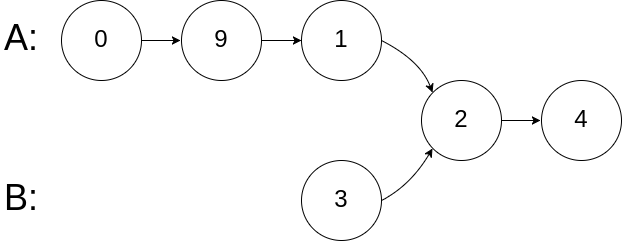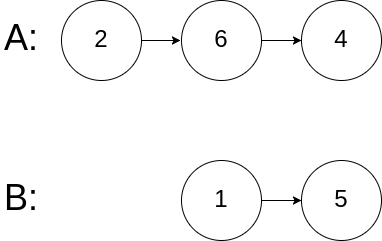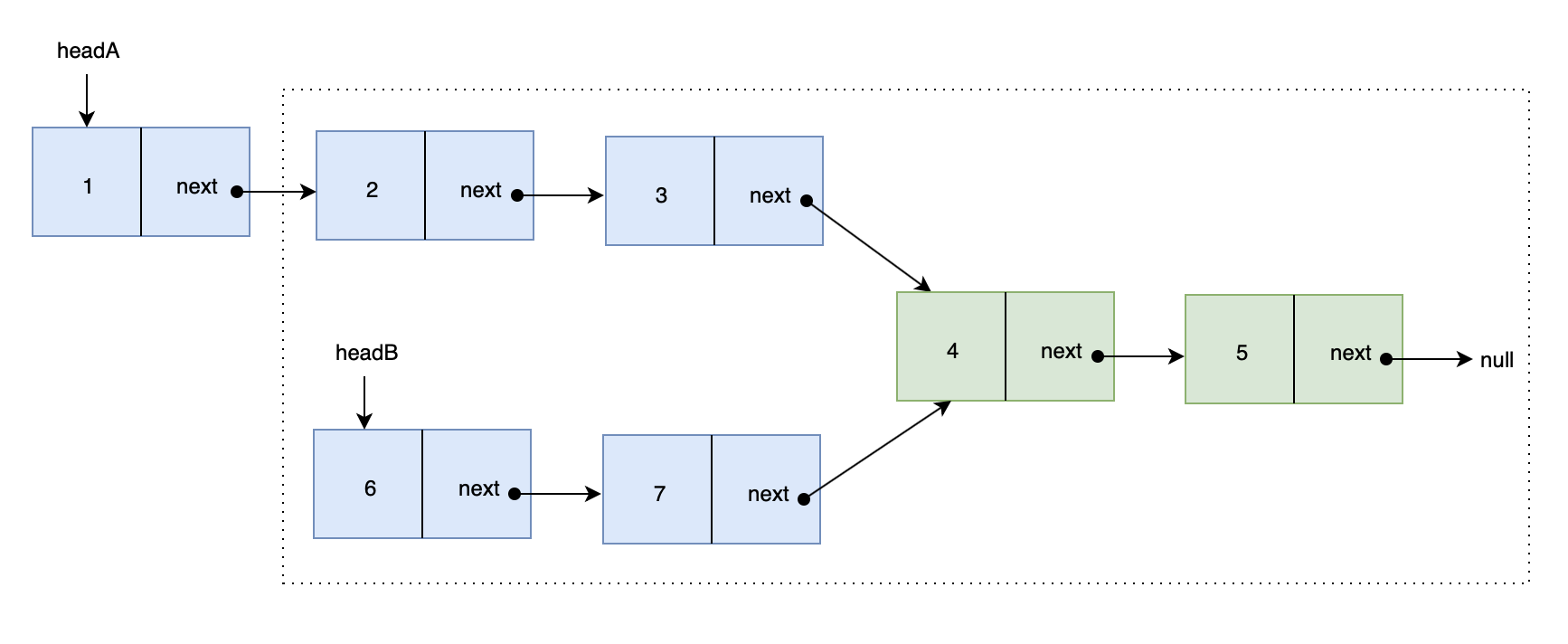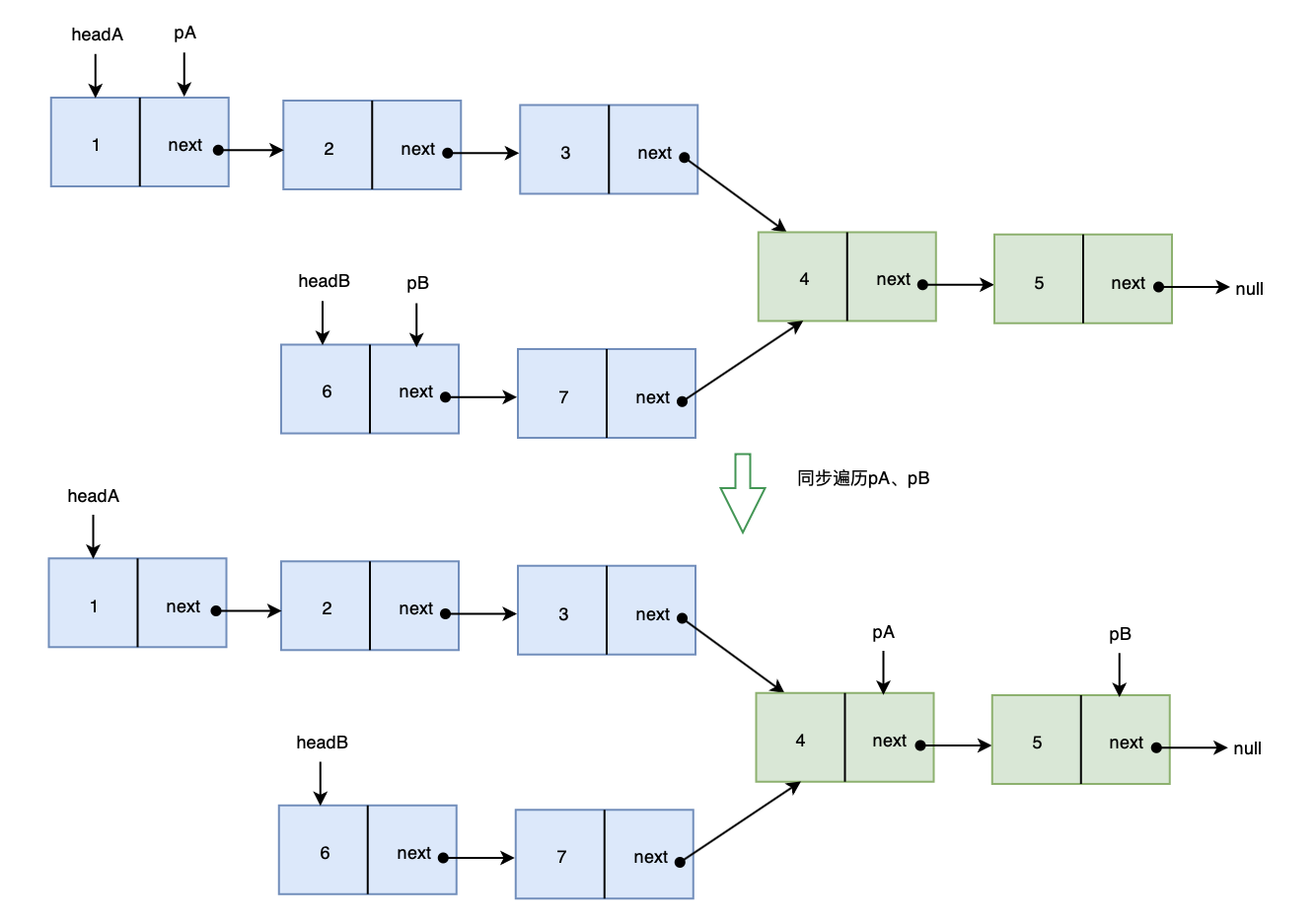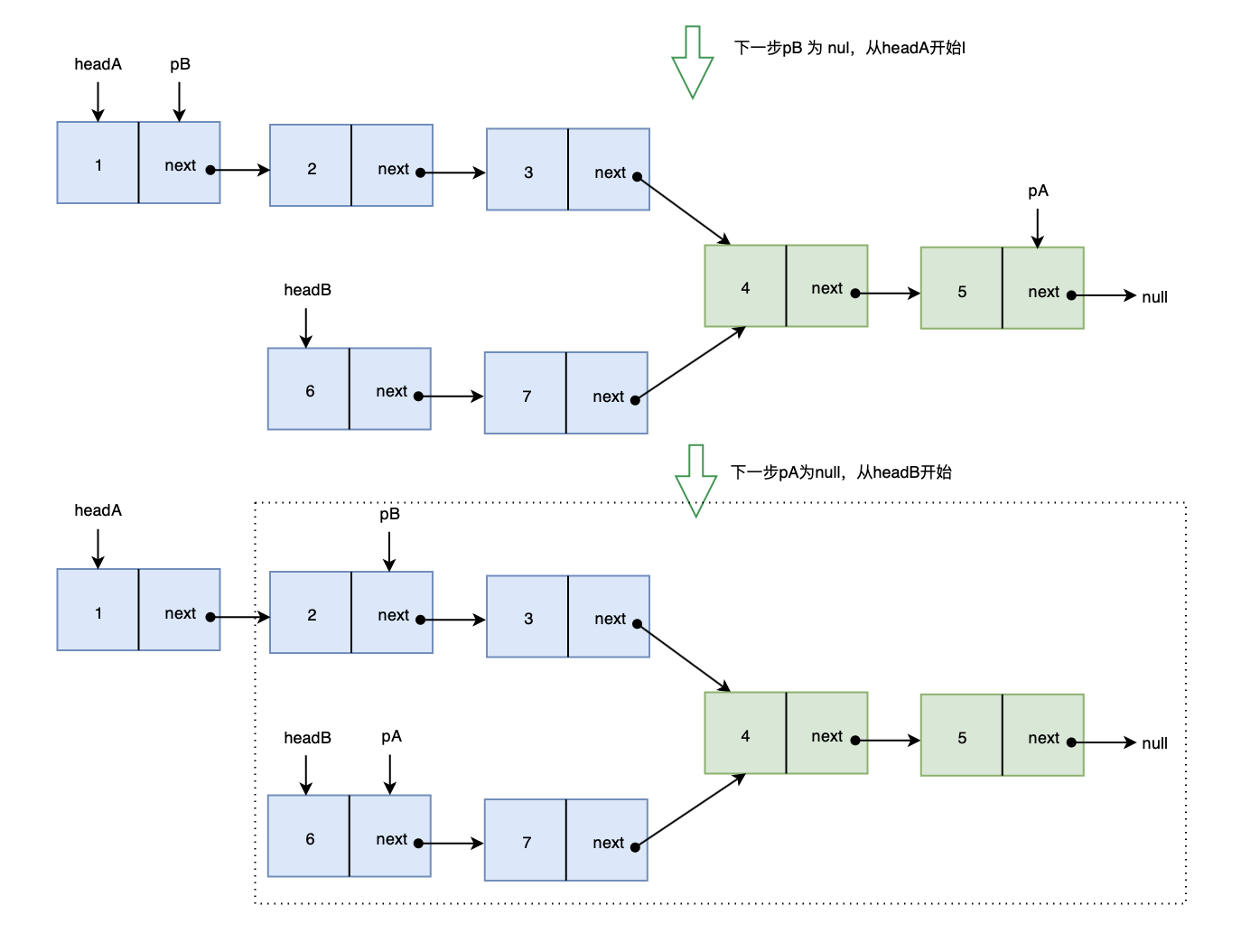图解字节&leetcode160:编写一个程序,找到两个单链表相交的起始节点
sisterAn opened this issue · comments
编写一个程序,找到两个单链表相交的起始节点。
如下面的两个链表:
在节点 c1 开始相交。
示例 1:
输入:intersectVal = 8, listA = [4,1,8,4,5], listB = [5,0,1,8,4,5], skipA = 2, skipB = 3
输出:Reference of the node with value = 8
输入解释:相交节点的值为 8 (注意,如果两个列表相交则不能为 0)。从各自的表头开始算起,链表 A 为 [4,1,8,4,5],链表 B 为 [5,0,1,8,4,5]。在 A 中,相交节点前有 2 个节点;在 B 中,相交节点前有 3 个节点。示例 2:
输入:intersectVal = 2, listA = [0,9,1,2,4], listB = [3,2,4], skipA = 3, skipB = 1
输出:Reference of the node with value = 2
输入解释:相交节点的值为 2 (注意,如果两个列表相交则不能为 0)。从各自的表头开始算起,链表 A 为 [0,9,1,2,4],链表 B 为 [3,2,4]。在 A 中,相交节点前有 3 个节点;在 B 中,相交节点前有 1 个节点。示例 3:
输入:intersectVal = 0, listA = [2,6,4], listB = [1,5], skipA = 3, skipB = 2
输出:null
输入解释:从各自的表头开始算起,链表 A 为 [2,6,4],链表 B 为 [1,5]。由于这两个链表不相交,所以 intersectVal 必须为 0,而 skipA 和 skipB 可以是任意值。
解释:这两个链表不相交,因此返回 null。注意:
- 如果两个链表没有交点,返回 null.
- 在返回结果后,两个链表仍须保持原有的结构。
- 可假定整个链表结构中没有循环。
- 程序尽量满足 O(n) 时间复杂度,且仅用 O(1) 内存。
附leetcode地址:leetcode
方法:遍历
- 先将两个链表转换成数组结构
- 对其中一个数组进行遍历,每次遍历判断另一个数组是否含有该值
- 遍历结束后如果没有找到就返回 null
function intersectNode( head1, head2 ) {
var arr1 = [],
arr2 = [],
theValue = null;
transformToArray( head1, arr1 );
transformToArray( head2, arr2 );
for (var i = 0; i < arr1.length; i++) {
if( arr2.indexOf(arr1[i]) !== -1 ){
theValue = arr1[i];
return 'Reference of the node with value = ' + theValue;
}
}
return theValue;
/*
arr1.some( value => {
if ( arr2.includes(value) ){
theValue = value;
return true;
}
})
if( theValue ){
return 'Reference of the node with value = ' + theValue;
}
return null;
*/
}
function transformToArray( head, arr ) {
while( head ){
arr.push(head.val);
head = head.next;
}
}测试代码:
function CreateNode(val){
this.val = val;
this.next = null;
}
function CreateList(...nodes){
this.head = nodes[0];
this.length = nodes.length;
for( var i = 0; i < nodes.length - 1; i++ ){
if( nodes[i+1] ){
nodes[i].next = nodes[i+1];
}
}
}
function intersectNode( head1, head2 ) {
var arr1 = [],
arr2 = [],
theValue = null;
transformToArray( head1, arr1 );
transformToArray( head2, arr2 );
for (var i = 0; i < arr1.length; i++) {
if( arr2.indexOf(arr1[i]) !== -1 ){
theValue = arr1[i];
return 'Reference of the node with value = ' + theValue;
}
}
return theValue;
}
function transformToArray( head, arr ) {
while( head ){
arr.push(head.val);
head = head.next;
}
}
const node1 = new CreateNode(1);
const node2 = new CreateNode(2);
const node3 = new CreateNode(3);
const node4 = new CreateNode(4);
const node5 = new CreateNode(5);
const nodeA = new CreateNode('A');
const nodeB = new CreateNode('B');
const nodeC = new CreateNode('C');
const nodeD = new CreateNode('D');
const nodeE = new CreateNode('E');
const list1 = new CreateList(node1, node2, node3, node4, node5);
const list2 = new CreateList(nodeA, nodeB, node3, nodeC, nodeD);
intersectNode(list1.head, list2.head);- 将一个链表的值放入 map, 遍历另一个链表,判断有无该节点
var getIntersectionNode = function (headA, headB) {
var map = new WeakMap()
while (headA) {
map.set(headA, true)
headA = headA.next
}
while (headB) {
var curr = map.get(headB)
if (curr) return headB
headB = headB.next
}
return null
};解法一:标记法(简单但空间复杂度为O(n),不符合,仅做参考)
解题思路: 两次遍历,先遍历一个链表,给链表中的每个节点都增加一个标志位,然后遍历另外一个链表,遍历到第一个已被标志过的节点为两链表相交的起始节点。
若遍历完都没有发现已被标志过的节点,则两链表不相交,返回 null
const getIntersectionNode = function(headA, headB) {
while(headA) {
headA.flag = true
headA = headA.next
}
while(headB) {
if (headB.flag) return headB
headB = headB.next
}
return null
};时间复杂度:O(n)
空间复杂度:O(n)
解法二:双指针法
解题思路: 如果 A、B 两链表相交,则 A 、B 自相交点往后的链表是一致的。
我们可以尝试消除 A、B 链表的长度差,同步遍历上图中的方框里的节点,判断是否有相同节点,若有相同则是两链表相交,返回第一个相同节点 即可。否则返回 null ,两链表不相交。
解题步骤:
- 同步遍历 A、B 链表
pA、pB,直到遍历完其中一个链表(短链表),如上图,设A为长链表 - 那么此时 A、B 两遍表的长度差就为
pA到链尾的长度,此时可以把pB指向长链表的表头headA,继续同步遍历,直到遍历完长链表 - 此时,
headA到pB的长度就为两链表的长度差,pB到链表的长度与headB到链尾的长度一致 - 此时,可将
pA指向headB,然后同步遍历pB及pA,直到有相交节点,返回相交节点,否则返回null
画图帮助理解:
const getIntersectionNode = function(headA, headB) {
// 清除高度差
let pA = headA, pB = headB
while(pA || pB) {
if(pA === pB) return pA
pA = pA === null ? headB : pA.next
pB = pB === null ? headA : pB.next
}
return null
};时间复杂度:O(n)
空间复杂度:O(1)
方法:遍历
- 先将两个链表转换成数组结构
- 对其中一个数组进行遍历,每次遍历判断另一个数组是否含有该值
- 遍历结束后如果没有找到就返回 null
function intersectNode( head1, head2 ) { var arr1 = [], arr2 = [], theValue = null; transformToArray( head1, arr1 ); transformToArray( head2, arr2 ); for (var i = 0; i < arr1.length; i++) { if( arr2.indexOf(arr1[i]) !== -1 ){ theValue = arr1[i]; return 'Reference of the node with value = ' + theValue; } } return theValue; /* arr1.some( value => { if ( arr2.includes(value) ){ theValue = value; return true; } }) if( theValue ){ return 'Reference of the node with value = ' + theValue; } return null; */ } function transformToArray( head, arr ) { while( head ){ arr.push(head.val); head = head.next; } }测试代码:
function CreateNode(val){ this.val = val; this.next = null; } function CreateList(...nodes){ this.head = nodes[0]; this.length = nodes.length; for( var i = 0; i < nodes.length - 1; i++ ){ if( nodes[i+1] ){ nodes[i].next = nodes[i+1]; } } } function intersectNode( head1, head2 ) { var arr1 = [], arr2 = [], theValue = null; transformToArray( head1, arr1 ); transformToArray( head2, arr2 ); for (var i = 0; i < arr1.length; i++) { if( arr2.indexOf(arr1[i]) !== -1 ){ theValue = arr1[i]; return 'Reference of the node with value = ' + theValue; } } return theValue; } function transformToArray( head, arr ) { while( head ){ arr.push(head.val); head = head.next; } } const node1 = new CreateNode(1); const node2 = new CreateNode(2); const node3 = new CreateNode(3); const node4 = new CreateNode(4); const node5 = new CreateNode(5); const nodeA = new CreateNode('A'); const nodeB = new CreateNode('B'); const nodeC = new CreateNode('C'); const nodeD = new CreateNode('D'); const nodeE = new CreateNode('E'); const list1 = new CreateList(node1, node2, node3, node4, node5); const list2 = new CreateList(nodeA, nodeB, node3, nodeC, nodeD); intersectNode(list1.head, list2.head);
想法不错,不过可以进阶一下,使用双指针来做,使之尽量满足空间复杂度O(1)
方法:遍历
- 先将两个链表转换成数组结构
- 对其中一个数组进行遍历,每次遍历判断另一个数组是否含有该值
- 遍历结束后如果没有找到就返回 null
function intersectNode( head1, head2 ) { var arr1 = [], arr2 = [], theValue = null; transformToArray( head1, arr1 ); transformToArray( head2, arr2 ); for (var i = 0; i < arr1.length; i++) { if( arr2.indexOf(arr1[i]) !== -1 ){ theValue = arr1[i]; return 'Reference of the node with value = ' + theValue; } } return theValue; /* arr1.some( value => { if ( arr2.includes(value) ){ theValue = value; return true; } }) if( theValue ){ return 'Reference of the node with value = ' + theValue; } return null; */ } function transformToArray( head, arr ) { while( head ){ arr.push(head.val); head = head.next; } }测试代码:
function CreateNode(val){ this.val = val; this.next = null; } function CreateList(...nodes){ this.head = nodes[0]; this.length = nodes.length; for( var i = 0; i < nodes.length - 1; i++ ){ if( nodes[i+1] ){ nodes[i].next = nodes[i+1]; } } } function intersectNode( head1, head2 ) { var arr1 = [], arr2 = [], theValue = null; transformToArray( head1, arr1 ); transformToArray( head2, arr2 ); for (var i = 0; i < arr1.length; i++) { if( arr2.indexOf(arr1[i]) !== -1 ){ theValue = arr1[i]; return 'Reference of the node with value = ' + theValue; } } return theValue; } function transformToArray( head, arr ) { while( head ){ arr.push(head.val); head = head.next; } } const node1 = new CreateNode(1); const node2 = new CreateNode(2); const node3 = new CreateNode(3); const node4 = new CreateNode(4); const node5 = new CreateNode(5); const nodeA = new CreateNode('A'); const nodeB = new CreateNode('B'); const nodeC = new CreateNode('C'); const nodeD = new CreateNode('D'); const nodeE = new CreateNode('E'); const list1 = new CreateList(node1, node2, node3, node4, node5); const list2 = new CreateList(nodeA, nodeB, node3, nodeC, nodeD); intersectNode(list1.head, list2.head);想法不错,不过可以进阶一下,使用双指针来做,使之尽量满足空间复杂度O(1)
解法一:标记法(简单但空间复杂度为O(n),不符合,仅做参考)
解题思路: 两次遍历,先遍历一个链表,给链表中的每个节点都增加一个标志位,然后遍历另外一个链表,遍历到第一个已被标志过的节点为两链表相交的起始节点。
若遍历完都没有发现已被标志过的节点,则两链表不相交,返回
nullvar getIntersectionNode = function(headA, headB) { while(headA) { headA.flag = true headA = headA.next } while(headB) { if (headB.flag) return headB headB = headB.next } return null };时间复杂度:O(n)
空间复杂度:O(n)
解法二:双指针法
解题思路: 如果 A、B 两链表相交,则 A 、B 自相交点往后的链表是一致的。
我们可以尝试消除 A、B 链表的长度差,同步遍历上图中的方框里的节点,判断是否有相同节点,若有相同则是两链表相交,返回第一个相同节点 即可。否则返回
null,两链表不相交。解题步骤:
- 同步遍历 A、B 链表
pA、pB,直到遍历完其中一个链表(短链表),如上图,设A为长链表- 那么此时 A、B 两遍表的长度差就为
pA到链尾的长度,此时可以把pB指向长链表的表头headA,继续同步遍历,直到遍历完长链表- 此时,
headA到pB的长度就为两链表的长度差,pB到链表的长度与headB到链尾的长度一致- 此时,可将
pA指向headB,然后同步遍历pB及pA,直到有相交节点,返回相交节点,否则返回null画图帮助理解:
var getIntersectionNode = function(headA, headB) { // 清除高度差 let pA = headA, pB = headB while(pA || pB) { if(pA === pB) return pA pA = pA === null ? headB : pA.next pB = pB === null ? headA : pB.next } return null };时间复杂度:O(n)
空间复杂度:O(1)
你好,我想问一下,if(pA === pB) return pA。这行代码怎么理解?题目表示是两个单独的链表,链表里的节点都是对象,对象的这种===会有效吗?他们两个好像是指向不同的地址空间把。是不是应该比较pA与pB的值才行。改为if(pA.val===pB) return pA;会不会更好一点?
const getIntersectionNode = (head1, head2) => {
const h1 = head1
const h2 = head2
while (h1 || h2) {
if(h1.data === h2.data) return h1
h1 = h1 === null ? head2 : h1.next
h2 = h2 === null ? head1 : h2.next
}
return null
} WeakMap
var getIntersectionNode = function (headA, headB) {
let currenA = headA, currenB = headB;
let map = new WeakMap();
while(currenA) {
map.set(currenA, true);
currenA = currenA.next;
}
while(currenB) {
if(map.has(currenB)) return currenB.val;
currenB = currenB.next;
}
return null;
};双指针
var getIntersectionNode = function (headA, headB) {
let currentA = headA, currentB = headB;
while(currentA || currentB) {
if(currentB === currentA) return currentA;
currentA = currentA === null ? headB : currentA.next;
currentB = currentB === null ? headA : currentB.next;
}
return null;
};const getIntersectionNode = (headA, headB) => {
if (!headA || !headB) {
return null;
}
let tailA = headA;
let tailB = headB;
let stackA = [];
let stackB = [];
// 获取链表A的尾结点
while (tailA.next) {
stackA.push(tailA);
tailA = tailA.next;
}
// 获取链表B的尾结点
while (tailB.next) {
stackB.push(tailB);
tailB = tailB.next;
}
let count = 1;
while (stackA.length && stackB.length) {
// 如果尾结点相等,往前移动指针
if (tailA === tailB) {
tailA = stackA.pop();
tailB = stackB.pop();
count++;
}
// 否则代表到了不相交初了,终止遍历
else {
break;
}
}
/**
* count为1有两种情况
* 第一种:链表A和链表B都只有一个节点,那么判断他们是否相等即可
* 第二种:遍历俩链表都没有相等的节点,证明俩链表不相交,返回null
*/
if (count === 1) {
return tailA === tailB ? tailA : null;
}
/**
* 同理存在两种情况
* 第一种:遍历完俩链表,每个节点都相等,那么返回头节点
* 第二种:在不相交的节点处循环中断了,相交节点应该等于当前节点的下一个节点
*/
return tailA === tailB ? tailA : tailA.next;
};解法一:标记法(简单但空间复杂度为O(n),不符合,仅做参考)
解题思路: 两次遍历,先遍历一个链表,给链表中的每个节点都增加一个标志位,然后遍历另外一个链表,遍历到第一个已被标志过的节点为两链表相交的起始节点。
若遍历完都没有发现已被标志过的节点,则两链表不相交,返回
nullconst getIntersectionNode = function(headA, headB) { while(headA) { headA.flag = true headA = headA.next } while(headB) { if (headB.flag) return headB headB = headB.next } return null };时间复杂度:O(n)
空间复杂度:O(n)
解法二:双指针法
解题思路: 如果 A、B 两链表相交,则 A 、B 自相交点往后的链表是一致的。
我们可以尝试消除 A、B 链表的长度差,同步遍历上图中的方框里的节点,判断是否有相同节点,若有相同则是两链表相交,返回第一个相同节点 即可。否则返回
null,两链表不相交。解题步骤:
- 同步遍历 A、B 链表
pA、pB,直到遍历完其中一个链表(短链表),如上图,设A为长链表- 那么此时 A、B 两遍表的长度差就为
pA到链尾的长度,此时可以把pB指向长链表的表头headA,继续同步遍历,直到遍历完长链表- 此时,
headA到pB的长度就为两链表的长度差,pB到链表的长度与headB到链尾的长度一致- 此时,可将
pA指向headB,然后同步遍历pB及pA,直到有相交节点,返回相交节点,否则返回null画图帮助理解:
const getIntersectionNode = function(headA, headB) { // 清除高度差 let pA = headA, pB = headB while(pA || pB) { if(pA === pB) return pA pA = pA === null ? headB : pA.next pB = pB === null ? headA : pB.next } return null };时间复杂度:O(n)
空间复杂度:O(1)
我觉得 双指针消除高度差的方案, 时间复杂度并不是 On , 在 极限差的情况下 [4,1,8,4,5] , [5,0,1,8,4,5],假如相交的节点是最后一个点,会出现 遍历两遍链表的情况, 。
我自己实现了的方案,也是 双指针,但是最多只会遍历一次,不会出现遍历两遍的情况,
class Node {
public next: Node | undefined;
constructor (public element: any) {}
}
const getInsersectionNode = (headA: Node, headB: Node) => {
const map = new Map();
if (headA === headB) return headA;
let nextA: Node | undefined = headA;
let nextB: Node | undefined = headB;
while (nextA || nextB) {
if (map.get(nextA)) return nextA;
if (map.get(nextB)) return nextB;
if (nextA) {
map.set(nextA, true);
nextA = nextA.next;
}
if (nextB) {
map.set(nextB, true);
nextB = nextB.next;
}
}
return undefined;
};

